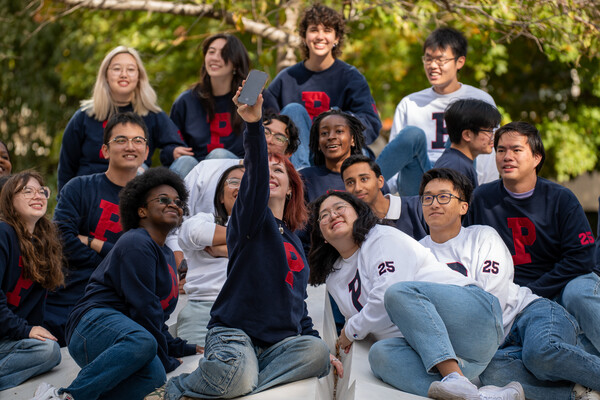Q&A with David Luzzi
With all the hoopla around nanotechnology, you’d think it was a brand new science. Not so, says David Luzzi, a professor of materials science and engineering in the School of Engineering and Applied Science. “It’s not a revolution,” says Luzzi, who is also the Penn director of the Nanotechnology Institute (NTI), a partnership among Penn, the Ben Franklin Technology Partners of Southeastern Pennsylvania, and Drexel University. “In many ways it’s just the continued progression of technological change. For decades and decades, probably centuries, we have been gaining by making things smaller.”
One of the earliest examples of what we now think of as nanotechnology—the science and technology of the very small—is the catalytic converter, which used a nanoporous ceramic matrix to achieve a major victory in pollution control in the 1970s. Now nanotechnology is on the brink of transforming everything from healthcare to electronics to the water we drink. At Penn, nanotechnology is mushrooming, with research happening in multiple schools. Small Times Magazine recently voted the University No. 1 in the country for nano research, and enrollment in Luzzi’s nanotechnology courses has gone up sixfold. “I’m having more fun now than I’ve had in my entire career here,” Luzzi says.
Q. You’re involved in high-level nano research, but can we talk about some of the ways nanotech is already a part of our everyday lives. Some of the recent advances in sports equipment, for example, come to us by way of nanotechnology.
A. Well that’s standard because any time a new class of materials comes along the first place you find it is in sports equipment because people are willing to spend more dollars per pound for sports equipment than anything else. In bicycles there’s one by BMC that’s a plastic resin with carbon fiber and carbon nanotubes in it. They get this great bicycle frame able to withstand 30-mile-an-hour pothole shocks but it weighs less than a kilogram. This one was in the Tour de France. In tennis there’s the Babolat VS nanotube power racket. The idea was to combine carbon nanotubes with graphite. It’s five times more rigid than carbon composite rackets, and they’re state of the art. Why do you want a rigid tennis racket? If you’re a really good player more rigid means more power transmitted to the ball, though it also means you have to be really accurate. Then there’s the Wilson nCode. What they discovered when they made their carbon fiber rackets was that where the fibers were there were tiny little gaps and when you hit there was a vibration which used energy that wasn’t being transmitted to the ball. So they mixed in silicone nanoparticles that filled that space and prevented that loss and gave them twice the strength and stability and 22 percent more power. This is the racket that Roger Federer uses.
Q. So that’s nano for the wealthy. What about the rest of us?
A. The real test of a technology is how early in its development you see value plays. [That’s where] I can provide you the same properties or marginally better but at a cost where you say it’s worth me investing in that. One of the things that’s interesting with nanotechnology is that fairly early in the game here we’re seeing clear value plays. And that is what separates nano from other technologies.
Q. Longer lasting tennis balls would fit in the value play category, right?
A. Yes, it’s going to bounce the same, have the same fuzz on the outside but inside the inner layer is a polymer nano clay composite.What they discovered was they can break clay up into very fine pieces and disperse it into polymers and plastics and get greatly reduced diffusion of gas. The way tennis balls lose their bounce is they lose pressure. This doubles the life of the balls at one and a half times the cost.
Q. Can you give me more examples of value play?
A. Nanotech in food is all value play. The Perrier plastic bottle also uses nanoparticles of clay. It keeps the Co2 inside. The number one way food flavor degrades is by oxygen. It’s also a negative in terms of aerobic bacteria processes that need oxygen. So the idea is you’re preserving flavor. For beer you’re preserving flavor but also keeping oxygen out and Co2 in. It extends the shelf life for six weeks.
Q. And what about those nano pants I’ve seen advertised?
A. They’re stain resistant pants. It’s a coating that has hydrophobic properties so it hates water and almost everything in the world is water-based so dirt beads. But in addition to that these molecules have shape memory so when your pants get wrinkled you throw them in the dryer and the heat causes them to go back to their original shape. So they come out of the dryer wrinkle free. You get that for an additional 10 bucks. There’s a company called Nano-Tex and Eddie Bauer sells them, for example. They’re called Nano-Tex pants.
Q. How is nanotechnology being used in skincare?
A. Remember those lifeguards with white noses? That was zinc oxide. If you look at the wavelengths of light you have really long wavelengths, which is infrared, and intermediate wavelengths, which is the light you see in all the colors of the spectrum, and you have ultraviolet, and that’s the kind that does damage to you. The zinc oxide of yore would scatter ultraviolet light but it would also scatter the visible light, which is why you see it. So what this company Nanophase did is they developed a method to make zinc oxide smaller. It’s not as simple as grinding it up because you also must make it so it doesn’t agglomerate; the particles have to stay separate. They tuned the size such that it stops scattering when it gets to visible light, so its invisible.
Q. Many at Penn, including you, are coming up with ways to use nanotechnology that could have a big impact on the future of medicine. Tell me about your research.
A. There are three basic thrusts of my research. One is carbon nanotubes. It’s probably a safe bet to say they’re the strongest material that will ever be discovered … a large part of what’s made my group’s name in nanotechnology has been the discovery of a class of materials that use the carbon nanotube as a base and then fill it to change its properties by controlling what goes inside it. It’s a pipe, but it has the thinnest wall you could ever have, just one atomic layer, and because of that you can think of doing a bunch of interesting things. If you want to have molecules that communicate with the world yet you want to protect that molecule from the world what you’d like to do is put it in a package that has the least wall between the inside and the outside. We’re also working on probes that can be used to go down into cells non-destructively because they’re so fine. The application isn’t so much in therapeutics but for example in cell sorting devices where you want to go down into cells and probe for disease states or whatever. These things would provide that capability.
The third part is nanoparticles designed to treat a class of cancer called metastatic solid tumor cancers, which are notoriously hard to treat because they’re throughout the body. In collaboration with Fox Chase we’ve taken radiation therapy, which works very well on tumors, and made it a distributed therapeutic. So we’ll go inside the body and we’ll deliver radiation doses that will attrit tumors but we’ll do it with targeted particles. The analogy I use is gunboats on the Mississippi. The Mississippi is the blood vessel and you go and dock your gunboat in the river and bomb the heck out of the city. It’s sort of like Grant and Vicksburg if you’re a Civil War buff. That’s the concept.
Oct. 25 is Nano Day at Penn. For details about the event, see News Briefs by clicking here.
Originally published on October 19, 2006.







